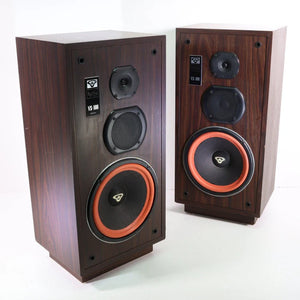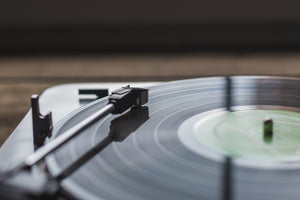We are unable to reply to comments, so please message us directly if you have a specific question regarding products, shipping costs, etc. Our office number is (480) 207-1511. Our email is hello@spencertified.com. You can also message us on Facebook. Commonly asked questions and answers can be found on our FAQs page here.

THE AGE OF SOUND: EVOLUTION OF THE SPEAKER
THE INCREDIBLE HISTORY BEHIND THE MODERN LOUDSPEAKER
Take a look around you: how many speakers are in the room? We’re willing to bet quite a few! There’s a speaker in everything now - smartphones, tablets, computers, headphones, TVs…the device you’re currently reading this on probably has one! And if you have a home theater system or an audio setup, then you’re surrounded by speakers big and small.
With this flood of speakers in our everyday life, it’s hard to imagine society without them. Sound and music follow us nearly everywhere, after all. But there was a time, not so long ago, when the very idea of speakers was impossible. So how did the speaker evolve into what it is today?
Let’s travel back to Once Upon a Time, when the speaker just came to be….
WHAT IS A SPEAKER?

First, what is a speaker? Well, in short, a modern loudspeaker uses a speaker driver that converts audio signals into sound. More specifically, it uses an electromagnet: an electrical current is sent through a voice coil, producing an electric field that interacts with the magnetic field of the magnet attached to the speaker. This interaction turns electric signals of varying strength into movement.
Surprisingly, the electromagnet part was the easy step. It was invented in the early 1860s. But it took four more decades to develop a clear enough knowledge of acoustics, electricity, materials, sound waves, radio, chemistry, and physics to turn those signals into waveforms that move an attached cone back and forth, creating the air pressure waves we perceive as sound.
THE FIRST SPEAKER

In 1861, Johann Philipp Reis developed a “simple” type of electronic speaker as an experiment for his telephone. It was able to reproduce noise, but the sound was muffled. It wasn’t until several years later that Alexander Graham Bell was able to produce a working speaker based on Reis’s work. In 1876, he got a patent for the first loudspeaker, which did produce clear and intelligible speech.
Credited with the invention of the first truly practical telephone, people could speak to one another in normal voices over long distances. It wasn’t an electrodynamic loudspeaker but instead used a thin diaphragm attached to a magnet, suspended in a coil of wire. When an electrical current passed through the coil, it produced a magnetic field that caused the thin metal of the diaphragm to vibrate, producing sound waves.
This device paved the way for many future inventions. Creating something that could amplify sound and telegraph signals over a long distance was a vital step into developing our modern speakers.
EVOLUTION OF THE SPEAKER

So, the first speakers were used in telephones. What happened next?
Well, inventors continued to invent. In the year after Bell’s patent, 1877, a man named Werner Von Siemens used Bell’s basic design to create an electromagnetic coil-driven speaker. This attempt wasn’t successful, but it was an incredible step forward; this type of speaker is still being used even today!
It was Oliver Lodge who created the first cone-shaped loudspeaker in 1898. He developed the first experimental moving coil loudspeaker by attaching a metal cone to a phonograph. His idea of using the cone to convert electrical energy recorded on wax discs into sound waves marked a new beginning in an era of sound.
Based on his concept, Peter Jensen and Edwin Pridham designed the first practical moving coil loudspeakers in 1915. The design continued to improve until, in 1924, General Electric’s Chester Rice and AT&T’s Edward Kellogg teamed up to create the Radiola Loudspeaker #104. This speaker boosted sound pressure and frequency response to reproduce clear, crisp audio for the first time.
Speakers eventually grew prominent enough to make their way into mainstream society: the radio, PA system, and television all became possible and popularized thanks to the speaker.
THE MODERN SPEAKER

The world exploded into sound. Soon music held the airwaves and it quickly migrated into the home, largely in thanks to Edgar Villchur. He invented acoustic suspension for duplex drives, which produced better bass in smaller cabinets. This meant that speakers eventually grew more portable and compact: in the 80s you had your boombox, in the 90s your Walkman. Having music on the go gradually led the world to portable Bluetooth speakers, car radios, and smartphones.
The 2-way and 3-way speakers bloomed into existence as well. Meyer Sound Laboratories invented the powered speaker in 1980, introducing the world to tweeters for high-frequency sounds and woofers for low-frequency sounds. They used crossover circuitry (which is still used today) to feed the signals to both drivers, creating a full spectrum of sound. Then the mid-range driver danced onto the scene to handle middle frequencies.
Now, we have home theater systems and audio setups with 7.1-channel surround sound. There are soundbars, front speakers, center speakers, rear speakers, surround speakers…inside speakers, outside speakers, water-proof speakers…even ceiling-mountable speakers! The modern speaker is crisp, clear, and versatile.
SUMMARY
Speakers are all around us from the teeny ones in your headphones to the large ones in your home theater system. They are such a natural part of most people’s lives that we don’t even consciously take notice of them anymore. But once upon a time, replicating and amplifying sound was a mind-boggling impossibility.
But lucky for us, people found a way to make the impossible possible. Compared to where speaker technology was at a couple hundred years ago, sound has come a long way. We’re excited to see where it will go from here. How about you?
Thanks for reading! We hope you learned something new about speakers. If we’ve tickled your curiosity and you’re interested in shopping our wide selection of refurbished speakers, you can check them out here! You can also upgrade your sound system with our receivers and amplifiers that you can find here. Have a wonderful day!



Comments
Leave a comment